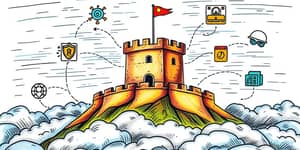
In today’s high-stakes digital environment, organizations face a continuous barrage of sophisticated cyber threats aiming to disrupt operations, steal sensitive data, or damage reputations. A single successful breach can cost millions in recovery expenses and lost business, underscoring the need for a structured set of standards and rules. Crafting a tailored risk management program enables teams to identify vulnerabilities early and allocate resources efficiently. By embracing a proactive risk identification and response mindset, leaders can strengthen defenses and build a culture of resilience that supports long-term strategic objectives.
Risk management is not a one-off exercise but a continuous process that adapts to emerging technologies like artificial intelligence and cloud computing. When embedded into organizational culture, risk frameworks transform cybersecurity from a reactive necessity into a strategic asset driving sustainable growth.
Risk management in cybersecurity involves identifying, assessing, and mitigating threats to critical assets. The ultimate goal is to protect data systems, maintain integrity, and ensure availability amid evolving attack tactics. A robust framework empowers decision-makers to quantify potential impacts and allocate resources effectively.
At its core, the Risk Management Framework (RMF) provides a comprehensive methodology to minimize risks to data systems through repeatable processes. This encourages continuous improvement and builds stakeholder confidence by demonstrating a well-governed security posture.
A well-defined RMF aligns security investments with business priorities and regulatory obligations. It sets clear expectations for stakeholders, from executives to technical teams, ensuring that risk decisions consider financial impact, operational constraints, and compliance requirements. Through repeatable cycles of assessment and adjustment, organizations can remain ahead of threat actors while optimizing expenditure.
A mature RMF consists of key building blocks that work together as a unified defense strategy. The following table outlines the primary components and their purpose.
Continuous oversight is vital; ongoing review of risk status ensures defenses remain adaptive. Security Information and Event Management (SIEM) tools, such as Splunk or IBM QRadar, aggregate logs and flag anomalies, enabling security operations centers to investigate incidents quickly. Automated alerts, combined with manual analysis, help maintain situational awareness, drive faster remediation, and refine controls based on real-world attack patterns.
Popular frameworks guide organizations through standardized processes and best practices, fostering consistency and regulatory alignment. Key frameworks include:
By adopting one or more of these methodologies, teams establish a solid foundation for risk governance and improve cross-functional collaboration between IT, compliance, and business leadership. These frameworks also provide comprehensive documentation and audit trails, simplifying both internal reviews and external regulatory audits. Organizations often tailor framework controls to reflect sector-specific risk appetites and detector capabilities, creating a balance between rigor and practicality.
Embedding risk management into each phase of the System Development Life Cycle (SDLC) ensures that security considerations are addressed from inception through deployment. This approach prevents costly retrofits and reduces vulnerability windows.
A successful integration strategy requires strong partnerships across departments. Incorporating security, privacy, and supply chain risk management during requirements gathering and design stages helps anticipate third-party risks and enforces security by design principles.
Real-world examples highlight success stories: government agencies integrating risk checkpoints at design phases report 30% fewer vulnerabilities in production code, while financial institutions see faster compliance audit cycles. Cross-functional teams that include risk, legal, and procurement stakeholders can navigate complex supply chain dependencies more smoothly.
Human expertise drives the framework forward. Well-defined roles and responsibilities foster accountability, while procedural rigor maintains consistency. Regular training programs and simulated exercises keep teams prepared for emerging threats. Investing in innovative tech, from next-generation firewalls to threat intelligence platforms, complements human judgment and accelerates response time.
Conducting detailed threat analysis leverages both internal data and external intelligence feeds. Incorporating open-source and commercial threat intelligence enables early detection of new malware strains and attack campaigns. Organizations can prioritize controls based on potential business impact, ensuring that scarce resources protect the most critical assets first. Dynamic risk matrices and heat maps visualizing high-risk areas further aid decision-making.
Adherence to regulations such as GDPR, FISMA, and industry-specific mandates is non-negotiable. Non-compliance may result in severe penalties—Meta’s €1.2 billion GDPR fine in 2023 underscores this reality. Integrating a Governance, Risk, and Compliance (GRC) platform simplifies policy management and reporting.
Equally crucial is establishing an incident response capability to contain breaches swiftly. A well-practiced playbook, clear communication channels, and forensic readiness reduce downtime and limit reputational damage. Incident response is strengthened by periodic tabletop exercises and clear escalation procedures. Integrating communication plans with legal, PR, and executive teams ensures that stakeholders remain informed and aligned during a crisis. Post-incident reviews capture lessons learned, feeding back into risk assessments and mitigation strategies to close gaps proactively.
Risk management is an iterative journey. By leveraging metrics, such as mean time to detect (MTTD) and mean time to respond (MTTR), organizations can refine controls and optimize workflows. Metrics and KPIs, such as control coverage percentage and risk reduction rates, guide leaders in evaluating program effectiveness. Benchmarking against industry peers and adopting lessons from recent breaches accelerates maturation. continuous monitoring and assessment identify drift in control performance, prompting timely updates and recalibrating risk tolerances when business conditions change.
Implementation yields tangible outcomes: it enhances ability to respond to threats, reduces financial losses, and fosters trust among stakeholders. Demonstrating a mature risk posture attracts partners and clients who demand high assurance levels.
The average global cost of a data breach surpassed $4.5 million in 2023 and continues to climb. Organizations face increasingly sophisticated attacks, including AI-driven intrusions and targeted supply chain compromises. Staying ahead requires foresight and agility.
Regulatory bodies are enhancing requirements around supply chain security and third-party risk. Mandatory reporting of ransomware payments and breach timelines underscores the need for transparent communication. Emerging regulations, including proposed amendments to the Cyber Incident Reporting for Critical Infrastructure Act (CIRCIA), will tighten deadlines for incident disclosures, increasing pressure on organizations to strengthen defenses. Looking to 2025, the rise of zero-day exploits and emerging advanced persistent threats means that static defenses are insufficient. Proactive intelligence gathering, continuous training, and strategic investments will distinguish resilient organizations from those struggling to adapt.
Building a robust risk management framework is not a one-time project but a dynamic commitment to security excellence. By harmonizing people, processes, and technology, organizations can build a robust cybersecurity defense tailored to their unique needs and risk appetite.
The journey to fortify digital assets requires vision, collaboration, and relentless pursuit of excellence. By choosing and tailoring a comprehensive RMF, organizations demonstrate a commitment to protecting stakeholders and preserving trust in an uncertain cyber landscape.
References













